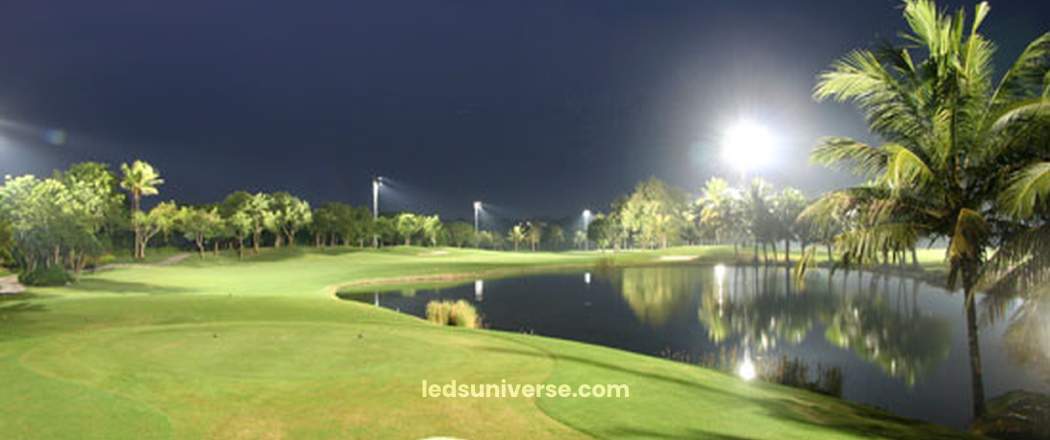As the sun begins its descent, casting a warm glow over the lush expanse of the golf course, the landscape transforms into a breathtaking sight. With darkness on the horizon, the need for illumination becomes clear—not only for safety but to enhance the course’s natural beauty and allow golfers to savor their game. Enter solar golf course lighting, an innovative solution that captures the sun’s energy to illuminate paths, greens, and surroundings, creating a lively environment where players can enjoy the sport well into the night.
The world of golf is constantly evolving, and as more golf courses seek ways to enhance their facilities and improve player experiences, lighting plays a significant role. Golf course lighting is vital for extending play hours, enhancing safety, and improving aesthetics. As sustainability becomes an increasing focus in various industries, solar golf course lighting has emerged as a promising solution. Harnessing solar energy offers a range of benefits, from cost savings to environmental advantages.
Reach out for free lighting consultation
Table of Contents
ToggleSolar golf course lighting brings forth a multitude of benefits that align with the growing demand for sustainable practices. One of the most appealing aspects of solar lighting is its reduced impact on the environment. By utilizing solar energy, golf courses can significantly decrease their reliance on non-renewable energy sources, leading to a reduction in greenhouse gas emissions. The environmental benefits extend beyond mere energy savings; they also contribute to a more eco-friendly image for the golf course, appealing to environmentally conscious golfers.

Harnessing solar energy significantly reduces the carbon footprint of golf courses, aligning them with global efforts to mitigate climate change. By transitioning to a renewable energy source, golf courses contribute to a broader movement toward sustainability, showcasing their commitment to environmental stewardship. This shift not only minimizes the reliance on fossil fuels but also lowers greenhouse gas emissions, creating a healthier ecosystem for wildlife and plant life on and around the course. As awareness of environmental issues continues to grow among the golfing community and beyond, courses that adopt solar lighting enhance their image as pioneers in sustainable practices. This proactive stance resonates with eco-conscious players, who are increasingly looking for venues that prioritize environmental responsibility. By integrating solar solutions, golf courses can position themselves as leaders in the industry, attracting a clientele that values sustainability and is eager to support eco-friendly initiatives.
Transitioning to solar golf course lighting presents significant financial advantages, particularly in terms of operational costs. Traditional lighting systems incur substantial electricity expenses, especially during peak hours when usage is highest. These costs can add up quickly, impacting the overall budget of the golf facility. However, with solar lighting, courses can drastically reduce or even eliminate their electricity bills, leading to substantial savings over time. Moreover, solar lighting systems typically require minimal maintenance compared to conventional options. This reduction in upkeep costs further enhances financial savings, allowing courses to allocate their budgets to other essential areas, such as course improvements or community engagement programs. The long-term financial benefits make solar lighting an attractive investment, offering not only immediate savings but also a stable and predictable cost structure for years to come.
Solar lighting plays a pivotal role in enhancing safety and playability on golf courses. Properly illuminated pathways, tees, and greens enable golfers to navigate the course with greater ease, particularly during twilight hours or in low-light conditions. Enhanced visibility is crucial for preventing accidents, ensuring that golfers can safely make their way to and from various parts of the course. Moreover, the presence of adequate lighting can deter unwanted incidents, providing a sense of security for players and staff alike. As a result, a well-lit course encourages more golfers to engage in evening rounds, contributing to increased participation and overall revenue for the golf facility. In addition to improving safety, solar lighting elevates the overall experience for players, allowing them to enjoy the beauty of the course under the stars and enhancing the appeal of the venue as a social gathering space.
One of the remarkable advantages of solar golf course lighting is its aesthetic flexibility. Unlike traditional lighting solutions that often come in limited styles and designs, solar fixtures are available in a diverse array of forms, sizes, and colors. This variety allows golf courses to select lighting that complements their unique landscapes and architectural styles. Customizable solar lighting solutions can be tailored to enhance specific features of the course, such as highlighting beautiful trees, water hazards, or signature holes. This attention to design not only elevates the visual appeal of the course but also creates a more inviting atmosphere for players and guests. Thoughtfully designed lighting can transform a golf course into an enchanting nighttime venue, attracting players who wish to experience the beauty of the course after sunset. Ultimately, the ability to integrate aesthetics with functionality enables golf courses to create a memorable environment that leaves a lasting impression on visitors.
The variety of solar lighting options available for golf courses caters to different needs and preferences. Solar LED lights are among the most popular choices due to their energy efficiency and longevity. These lights consume significantly less power compared to traditional incandescent bulbs and offer an impressive lifespan, often lasting up to 50,000 hours. Additionally, LED lights provide a bright, clear illumination that enhances visibility without being harsh on the eyes.
Solar LED lights are favored for their efficiency and long lifespan. They offer consistent lighting quality while minimizing energy consumption, making them ideal for various applications around the course. The versatility of LED technology allows for tailored solutions, from illuminating practice areas to enhancing clubhouse surroundings.
Solar flood lights are another excellent option for illuminating large areas such as fairways, practice ranges, and parking lots. They are designed to cast broad beams of light, ensuring that expansive spaces are well-lit. These flood lights can be strategically placed to provide optimal coverage, creating a safe environment for golfers and staff alike.
For pathways and accent lighting, solar pathway lights and decorative fixtures can enhance both safety and aesthetics. These lights not only guide players along designated paths but also contribute to the overall ambiance of the course. By selecting fixtures that complement the course’s landscape and architectural style, golf courses can create a welcoming atmosphere.
In recent years, innovative solar technologies have led to the development of smart solar lighting solutions. These systems can incorporate sensors that adjust brightness levels based on ambient light conditions or detect motion, ensuring efficient energy use. Integrating smart technology into solar lighting can further elevate the golfing experience by providing tailored lighting solutions.
Transitioning to solar golf course lighting involves several considerations to ensure a successful implementation. The initial step is conducting a thorough site assessment to evaluate the layout of the course and identify key areas requiring illumination. Factors such as natural light availability, landscape features, and existing infrastructure play a vital role in determining the placement of solar lighting fixtures.
A comprehensive site assessment is fundamental for the successful installation of solar lighting. This involves analyzing the course’s topography, existing lighting needs, and potential obstacles that might hinder solar panel efficiency. Understanding these elements helps in making informed decisions about fixture placement.
Selecting the right solar lighting systems is another crucial aspect. With a range of products on the market, it is essential to evaluate different manufacturers and models. Considerations include the quality of the materials used, the technology integrated into the lighting systems, and warranty options. Working with reputable suppliers who specialize in solar lighting can help golf courses find solutions that align with their needs and budget.
The installation process for solar lighting is generally straightforward, especially when compared to traditional electrical systems. Solar lights typically do not require extensive wiring, making them easier and less expensive to install. However, professional installation is often recommended to ensure that the fixtures are optimally placed and angled to maximize solar exposure. Proper installation can enhance the performance of the lighting system and ensure long-term functionality.
Another essential consideration involves battery storage for solar lights. High-quality batteries are crucial for storing energy collected during the day, allowing the lights to operate effectively at night. Understanding the energy requirements and battery capacities is vital for ensuring that the lighting system operates as intended.

While the benefits of solar golf course lighting are compelling, challenges can arise during the transition. One common concern is the initial investment required for solar lighting systems. Although solar technology has become more affordable in recent years, the upfront costs can still be a barrier for some golf courses. To address this, many courses are exploring financing options or government incentives that promote renewable energy solutions.
The upfront costs associated with solar lighting can pose challenges for golf courses. While long-term savings are often substantial, securing initial funding can be difficult. Exploring financing options or partnership opportunities with renewable energy companies can help alleviate financial burdens.
Performance in varying weather conditions also poses challenges. Solar lighting systems rely on adequate sunlight for charging, and extended periods of cloudy weather can impact their effectiveness. To mitigate this issue, courses can invest in solar lights with higher battery capacities, ensuring they can operate during periods of limited sunlight. Additionally, selecting solar fixtures with energy-efficient technologies can help maximize performance.
Maintenance requirements for solar lighting are typically lower than those of traditional systems. However, periodic checks are still necessary to ensure that the solar panels are free of debris, and the batteries are functioning correctly. Establishing a maintenance schedule can help address these needs before they become issues, ensuring that the lighting systems continue to perform optimally.
Another challenge is overcoming misconceptions about solar technology. Some may view solar lighting as less reliable than traditional systems, leading to hesitation in making the switch. Education and outreach can play a significant role in changing perceptions. Demonstrating successful installations, sharing case studies, and providing information on advancements in solar technology can help alleviate concerns.
As golf courses consider the implementation of solar lighting, there are several additional points to keep in mind. First, understanding the local regulations and permitting processes related to solar installations is vital. Some regions may have specific guidelines or incentives for solar projects that can influence decision-making.
Understanding local regulations regarding solar installations is crucial for compliance and successful implementation. Regulations may vary significantly by region, affecting installation practices and permitting requirements. Familiarity with these guidelines can streamline the process and avoid potential setbacks.
Additionally, courses should assess their unique needs when choosing solar lighting solutions. Different areas of the course may require varying levels of illumination, and a one-size-fits-all approach may not yield the best results. Customizing lighting solutions to fit the specific requirements of each area can enhance functionality and aesthetics.
Collaboration with landscape architects and lighting designers can also elevate the quality of the lighting design. By working with professionals, golf courses can ensure that the lighting complements the natural surroundings while fulfilling practical needs. This collaborative approach can lead to innovative lighting designs that enhance the overall golfing experience.
The integration of solar golf course lighting stands as a testament to the commitment of golf facilities to embrace sustainable practices while enhancing the overall golfing experience. By taking advantage of the numerous benefits offered by solar technology, golf courses can create safer, more inviting environments while contributing to the protection of the planet. As the golf industry continues to evolve, the shift toward solar lighting represents a forward-thinking approach that aligns with the values of modern golfers and the future of the sport.